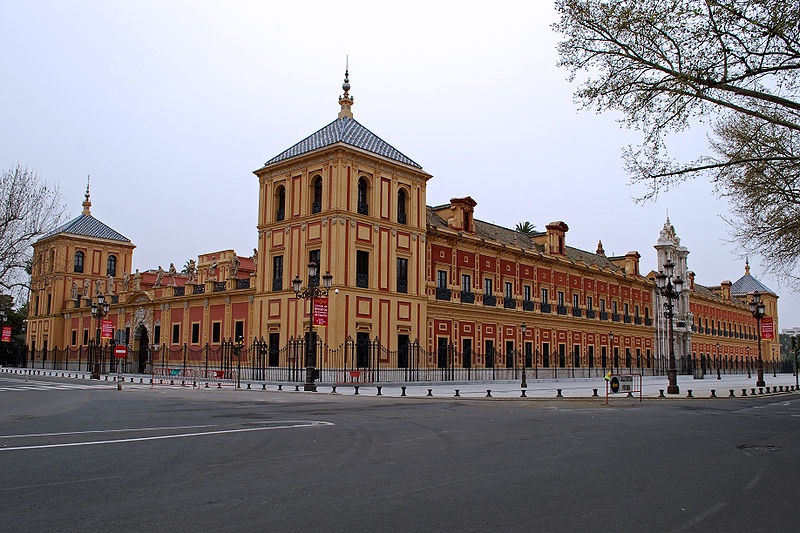 |
| Palacio San Telmo Junta's Presidency building |
Parallel administrations cost €2,500 million per year · Inventories at the Ministry and at the Council do not coincide
SEVILLA This article is of necessity full of figures. Not fuller figures, you understand: the (not-too-)popular cry these days being 'Trim down! Trim down! Trim down!' This call from Brussels makes Andalucía tremble, because we are the centre of attention in some of the corridors there. Or the Junta de Andalucía is. Spain's central government set targets for all the regional authorities that must be met by January 1, 2013. Therefore, 380 'public' (i.e. government) entities in this region must be trimmed down to 269, according to the Treasury. And that is where the problems start. COMING SOON: SUBSCRIPTION INFORMATION>>>
For example, the list of entities includes universities, but calculations by the Junta and by the unions, are different. Even the figures for various budgets in various governmental layers differ in their numbers.
The Junta was fast to move when in February 2011 it leaped to pull together a reorganization of the public sector in Andalucía. In a crazy fluttering of acronyms, lots of agencies and entities were brought together in often disparate marriages that are taking their time to be consummated.
Foundations, a 'public' process that in the past allowed for all sorts of financial manipulation (and corruption), looked like fish eating their own tails, swallowing each other in ever increasing circles. Agencies, fearful of indigestion, shed some of their more obscure associations (but put personnel to work elsewhere in the system). Giants were created, and smaller fry are destined for extinction.
Only accounting, no real changes
But the Junta, which is run by a coalition of the 'Left' (PSOE and IU, both in opposition to the PP in Madrid) doesn't like cutbacks, staff reductions. Absorption was the call word in the South. For example, 70 area offices of the Junta's agricultural support agency are to be sheltered under the provincial delegations of the Agricultural Council. Off one of the Junta's books and on to the books of the provinces. Smart move, you might say, but it is only a question of accounting. Nothing really changes: employees have to be paid no matter where they work, and in the end, it all comes back to the taxpayer's pennies.
Some redundancies have been made, but not nearly as many as are needed to make the books balance. The unions are complaining, which is their job. They don't do it very loudly, of course, and here's why: the Sindicato Andaluz de Funcionarios (SAF, Andalusian Union of Public Employees) says that their numbers have been reduced by 70 within the employment services, whereas the UGT-A (Unión General de Trabajadores-Andalucía) says the number is 800. Some difference.
The key, of course, is in the staff figures. The largest employer in the region is, surprise, the Junta de Andalucía, with a total of almost 260,000 employees. However, the number changes depending on who you ask and the 2012 regional budget for personnel of all levels amounted to €9,853million, up by 0.9% over 2011 - hardly within the spirit of constraints demanded by Madrid or Brussels. Indeed, the Junta spends almost one third of its total annual budget on its army of staff. Sounds like bad management. Or lack of it.
Can we be sure of the numbers at all? Not yet, apparently: on July 24, the Junta itself requested information on 'job posts, type of contract, pay structure and measures taken in matters of employment'. It gave them three months for its agencies, companies, foundations and consortiums to comply. No news yet, but the three months are not yet up. That was taken as an implicit confession of incompetence - the titan that doesn't control its hordes. But there are other ways of finding out.
We will not bore you with the figures, but sources such as the Central Register of Companies offer good information, as do other such independent entities.
The challenges
The dimensions of the conflict are monstruous, according to one online newspaper, which also says that the Junta will have to:
- Explain why it could not control growth within its parallel administrations, once official figures of their real state are expressed
- Justify reasons for its minimal redundancy programmes (it will be pressured from its IU coalition partner on this)
- Take on board the Supreme Court's decision regarding the allegedly illegal 'protocols on employment integration' (this is an oblique reference to the ERE scandal at the Junta), which, according to the Junta's own Supreme Court (TSJA) the principles of publicity, skills, equality and merit were not applied for access to jobs by the Junta.
It is a general opinion that Andalucía cannot continue in its present state. Even the head of a major union says that 'Employees have to be better selected. Duplication must be eliminated.' It is not about redundancies but about reassigning functions. These comments are from only one union leader, but they are all pretty much the same. What none of them mention, as far as we can tell, is that the problem might be one not so much of the number of hours at work, but about what most of them do in the time they're being paid for.
At any rate, the numbers dance in front of our faces but in the end it is not much more than cosmetics, of tricky accounting.
Will it pass the careful scrutiny of Brussels? Doubt it.

No comments:
Post a Comment